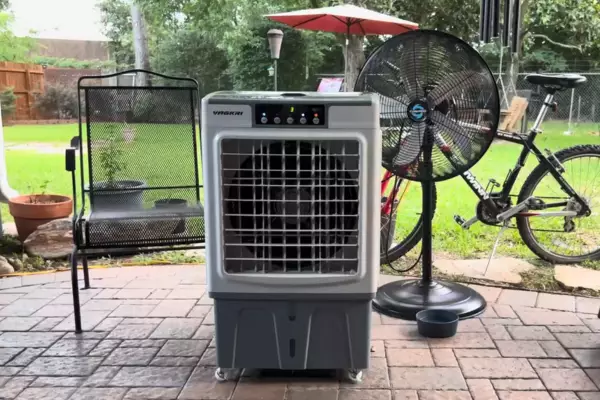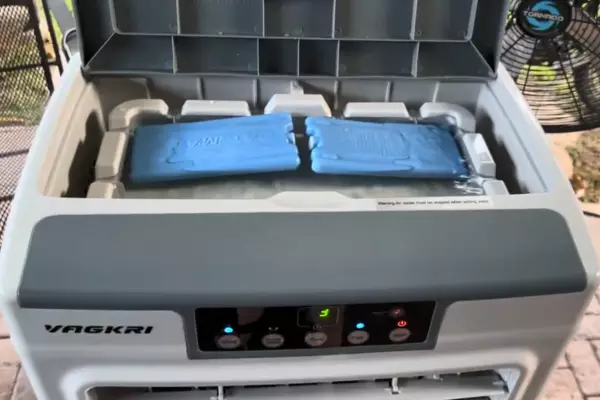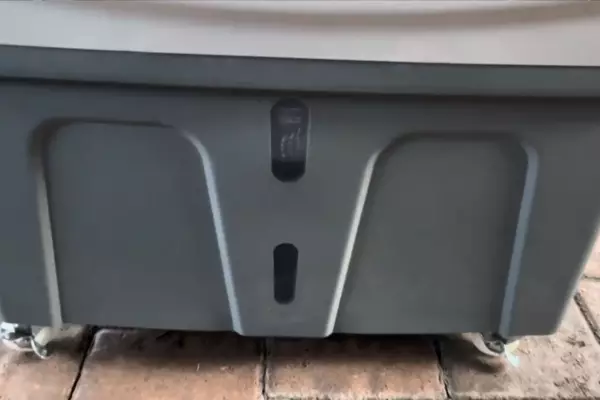Swamp coolers, also known as evaporative coolers, have become a popular cooling alternative due to their energy-efficient properties. These machines offer an affordable way to keep homes cool, especially in dry, arid climates. With their rise in popularity, new questions about their use are surfacing.
One of these questions revolves around the continuous operation of a swamp cooler. Simply put, you can run a swamp cooler 24/7. However, the real discussion goes beyond this simple answer, delving into aspects like energy consumption, device longevity, and indoor comfort.
The ability to run a swamp cooler all night is a matter of safety, energy costs, and the unit’s lifespan. There are certain considerations to take into account that we will further explore in this article.
Contents
What is a Swamp Cooler?
Basic Concept of Swamp Coolers
Swamp coolers are cooling devices that operate on the simple principle of evaporation. They work by pulling in hot, dry air, passing it through water-soaked pads to cool it, and then pushing it out to reduce the temperature in a room or building.
Operational Mechanism
The evaporative process in a swamp cooler is quite straightforward. The cooler’s fan draws in the warm outdoor air, which then passes over damp pads, causing the water to evaporate. This evaporation process absorbs heat, cooling the air before it’s circulated throughout the space.

Benefits of Swamp Coolers
Cost-Efficient Cooling
One of the primary advantages of swamp coolers is their cost-efficiency. They consume less electricity than traditional air conditioning systems, making them a cost-effective alternative for cooling homes.
Eco-Friendly Operation
Swamp coolers are more environmentally friendly than standard air conditioners. They don’t use refrigerants, which contribute to greenhouse gas emissions. Moreover, they naturally humidify the air, which can be a benefit in drier climates.
Humidity Benefits
Unlike air conditioners that remove humidity, swamp coolers add moisture to the air, which can prevent dry skin and eyes, and can even help sustain wood furniture and musical instruments that might crack in a dry environment.
Swamp Cooler Versus Traditional AC
Cost Differences
When it comes to cost, swamp coolers typically use up to 75% less electricity than traditional air conditioning systems. This difference can lead to significant savings on energy bills, especially during the hot summer months.
Impact on Environment
The environmental impact of swamp coolers is significantly less than that of conventional air conditioners. They do not use chemicals or emit harmful gases into the atmosphere. Additionally, they use a natural process (evaporation) to cool the air, making them a more sustainable option.
Maintenance Aspects
Swamp coolers generally require less maintenance than air conditioners. The absence of complex mechanical parts reduces the risk of breakdowns and prolongs the device’s lifespan. Regular cleaning and changing of the cooling pads are the primary maintenance tasks.

Running a Swamp Cooler 24/7
Energy Consumption Aspect
While swamp coolers use less energy than traditional air conditioning systems, running one 24/7 can still lead to higher energy consumption. Users need to balance the need for constant cooling with energy use and associated costs.
Longevity Concerns
Continuously running a swamp cooler can potentially reduce its lifespan. Consistent operation puts stress on the cooler’s parts, leading to faster wear and tear.
Effect on Indoor Comfort
Operating a swamp cooler non-stop can lead to overly humid conditions inside the home, which might cause discomfort. To prevent this, users should consider turning off the swamp cooler when the desired temperature is achieved.
Is it Okay to Run a Swamp Cooler 24/7?
Evaluating Safety Risks
Running a swamp cooler around the clock doesn’t pose significant safety risks as long as it’s maintained correctly. Unlike some heating devices, swamp coolers aren’t prone to creating a fire hazard. Still, regular upkeep, like cleaning the water tank and pads and checking the fan for any operational issues, ensures safe, trouble-free operation.
About Energy Costs
While it’s possible to operate a swamp cooler continuously, users should be aware of the impact on energy costs. These cooling systems are generally more energy-efficient compared to traditional AC units. However, consistent operation increases energy consumption, which in turn could lead to higher utility bills.
Impact on Swamp Cooler Lifespan
The components of a swamp cooler, like any mechanical device, undergo wear and tear during use. Running a swamp cooler continuously might speed up this wear, potentially reducing its lifespan. Regular maintenance can mitigate this to some extent, but users should consider periodic operation to prolong the cooler’s life.
Potential for Over-Humidification
An often overlooked aspect of running a swamp cooler 24/7 is the potential for creating overly humid conditions inside the home. Since swamp coolers add moisture to the air as they cool, they can make indoor environments feel clammy or uncomfortable if operated non-stop, especially in already humid conditions.

Can You Leave a Swamp Cooler On All Night?
Potential Benefits
Keeping a swamp cooler operational throughout the night can help maintain a comfortable temperature, a factor that becomes particularly valuable during sweltering summer nights. Consistent cooling can enhance sleep quality and overall comfort, contributing to a better quality of life.
Possible Drawbacks
Despite the benefits, running a swamp cooler all night might not always be the best choice. As night-time temperatures often drop, the cooler could lead to excessive indoor humidity. Over time, this could create an uncomfortably damp indoor environment and even lead to problems like mold growth if not properly managed.
Safety Precautions
If you decide to keep your swamp cooler on all night, ensure it’s well-maintained to prevent any potential hazards. Keeping the cooler clean, checking the water levels, and routinely examining the unit for operational issues will keep it running smoothly and safely.
Best Practices for Swamp Cooler Use
Routine Maintenance Tips
- Cooling Pads: Regularly cleaning or replacing the cooling pads ensures the unit’s efficient operation.
- Water Tank: A clean water tank prevents the buildup of mold and bacteria.
- Fan and Motor: Regular checks for any operational issues in the fan and motor can help prevent larger problems down the line.
Ideal Usage Patterns
Operating your swamp cooler efficiently requires strategic usage patterns. Consider turning it on during the hottest parts of the day and switching it off as the temperature drops. Operating the cooler in cycles rather than continuously can also help enhance its lifespan and maintain indoor comfort.
Overcoming Common Challenges
Excessive humidity can be a significant challenge when using a swamp cooler. To counter this, ensure your home has proper ventilation. You can open windows or doors slightly to allow the escape of moist air. Alternately, consider using a dehumidifier alongside the swamp cooler to maintain optimal indoor humidity levels.
Frequently Asked Questions
Does Running a Swamp Cooler 24/7 Increase My Electricity Bill?
Although swamp coolers are generally more energy-efficient than traditional AC units, running them continuously will inevitably increase energy consumption. This increased energy use can lead to higher electricity bills, especially during peak summer months when the cooler is likely to be used most.
Can I Leave My Swamp Cooler On When I’m Not Home?
Yes, it’s safe to leave your swamp cooler on when you’re not home. However, for optimal energy efficiency and to extend the life of the cooler, it’s recommended to turn it off if you’ll be away for an extended period. If you prefer to keep your home cooled while you’re out, consider using a programmable thermostat or timer to manage the cooler’s operation times.
Does Running a Swamp Cooler All Night Make My Home Too Humid?
It’s possible. Swamp coolers add moisture to the air as they cool, so running one throughout the night might result in excessive indoor humidity, especially if the cooler is oversized for the space or the outdoor temperature drops significantly at night. This excess moisture can make your home feel clammy or uncomfortable and could even contribute to mold growth if not addressed.
Conclusion
While swamp coolers provide a cost-effective and environmentally friendly cooling solution, especially in dry climates, their operation requires thoughtful consideration. Continuous operation, while possible, comes with its own set of implications related to energy costs, device longevity, and indoor comfort.
Leaving a swamp cooler on all night might enhance comfort during hot nights, but it’s important to weigh this benefit against potential energy costs and increased humidity. As with most things, balance is key – balancing the benefits of a cool, comfortable home with responsible energy use and consideration for the cooler’s lifespan.
Finally, proper maintenance and strategic operation are crucial to getting the most out of your swamp cooler. With the right care and usage patterns, a swamp cooler can be a great addition to your home, keeping you cool and comfortable even in the height of summer.

